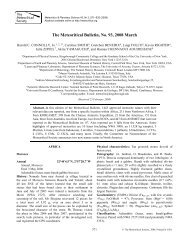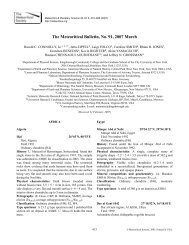You also want an ePaper? Increase the reach of your titles
YUMPU automatically turns print PDFs into web optimized ePapers that Google loves.
582<br />
Figure 12 Variation of iridium concentration in lunar<br />
regolith samples as a function of the maturity index<br />
Is/FeO, which is a magnetically determined measure of<br />
the abundance of ultra-fine-grained Fe 0 (which gradually<br />
accumulates through surface-regolithic processes)<br />
(Morris, 1978). <strong>The</strong> iridium data are from the<br />
compilation of Haskin and Warren (1991). A few soils<br />
of mixed mare–highland provenance (Apollo 17<br />
stations 2 and 3) are excluded for the sake of clarity.<br />
Mare regolith samples show a strong positive correlation<br />
between iridium and Is/FeO. Highland regolith<br />
samples feature generally higher iridium, and only a<br />
very weak correlation versus I s/FeO.<br />
impactites from the Apollo 14, 15, and 16 sites,<br />
where the siderophile components should be<br />
dominated by some combination of Imbrium,<br />
Serenitatis and (possibly, for Apollo 16 only)<br />
Nectaris ejecta, tend to feature remarkably nonchondritic<br />
siderophile patterns: Au/Ir is typically 3<br />
times, and Ni/Ir 2 times, the CI-chondritic ratios.<br />
<strong>The</strong> polymict impactites from Apollo 17, presumably<br />
dominated by ejecta from adjacent<br />
Serenitatis, feature similar but less extremely<br />
high Au/Ir and Ni/Ir. Among chondrites (Wasson<br />
and Kallemeyn, 1988), only the EH enstatite type<br />
has Au/Ir approaching the typical Apollo 14, 15,<br />
and 16 ratio. Korotev (1987b) and Korotev et al.<br />
(1998) has conjectured that high-Au/Ir and<br />
high-Ni/Ir iron meteorites (akin to the IAB type)<br />
impacted at both Serenitatis and the Apollo 16<br />
region. Morgan et al. (2001) argue that the high<br />
Au/Ir signature of late lunar accretion matches the<br />
composition they infer for the latest major<br />
accretion on Earth.<br />
Ringwood et al. (1987) advocated a very<br />
different interpretation of the high Ni/Ir ratios<br />
in Apollo 16 impactites. <strong>The</strong>se authors assumed<br />
that the meteoritic components have chondritic<br />
Ni/Ir, implying by mass balance (i.e., stripping<br />
away the meteoritic component based on iridium)<br />
<strong>The</strong> <strong>Moon</strong><br />
a high nickel concentration for the indigenous<br />
highland crust. This model appears implausible in<br />
view of nickel and iridium systematics in lunar<br />
highland meteorites, which tend to feature<br />
chondritic Ni/Ir, implying that the Apollo 16<br />
site happens to be unrepresentative (Warren et al.,<br />
1989, 2003).<br />
Attempts to use siderophile element data to<br />
constrain the amount of material added to the<br />
<strong>Moon</strong> after origin of its crust (Ryder, 1999;<br />
Hartmann et al., 2000) are plagued with<br />
tremendous uncertainties. <strong>The</strong> most straightforward<br />
approach is to average breccia data in<br />
the hope that the samples are representative of<br />
some portion of the lunar crust. Unfortunately,<br />
siderophile elements are unevenly distributed,<br />
and available samples may be grossly unrepresentative.<br />
For example, a single Apollo 14<br />
rock that consists of metal with noritic silicates<br />
(Albrecht et al., 1995) has 1,780 mg/g Ir, or 150<br />
times the mean highland (Apollo 14 and 16)<br />
regolith concentration, which itself may be<br />
significantly enriched by surface-micrometeoritic<br />
processing (Figure 12). This metal-rich rock<br />
suggests that meteoritic impactor siderophile<br />
components have tended to accumulate in<br />
dense metal at the bottom of large impact<br />
melts. It seems unrealistic to expect subsequent<br />
gardening to stir the crust so well that the<br />
uppermost megaregolith is representative of the<br />
whole.<br />
To utilize data for regolith samples, Ryder<br />
(1999) invoked a dubious “correction” of the<br />
observed iridium concentrations by assuming<br />
that, in each soil from a terrain older than the<br />
lavas atop which the Apollo 11 regolith formed<br />
(i.e., 3.6 Ga), 8.9 ng/g of iridium, the concentration<br />
found in the Apollo 11 regolith, was added by<br />
surface-micrometeoritic processing. This method<br />
ignored the high maturity (Is/FeO ¼ 78: Morris,<br />
1978) of the sparsely sampled Apollo 11 regolith.<br />
A less-mature regolith atop the same Tranquillitatis<br />
lava would have a much lower iridium<br />
concentration. Ryder’s method (cf. Hartmann<br />
et al., 2000) resulted in an estimate that an average<br />
highland regolith contains only 0.5 wt.% of CIchondritic<br />
equivalent (i.e., 2.6 ng/g of iridium) as a<br />
pre-3.6 Ga meteoritic component. Considering<br />
that the mare trend on Figure 12 extends from ,3<br />
to ,11 ng/g (the low end is not zero, because no<br />
mare soil is free of debris sprayed off the<br />
highlands), while the highland regoliths average<br />
,15 ng/g (with no clear correlation with maturity),<br />
it seems a more realistic estimate for the contribution<br />
of pre-3.6 Ga Ir in average highland soil<br />
would be 8–12 ng/g, i.e., 2 wt.% of CI-chondritic<br />
equivalent. In any event, a long extrapolation<br />
would be needed to relate any surface regolith<br />
constraint to the content of meteoritic siderophiles<br />
in the crust as a whole.





